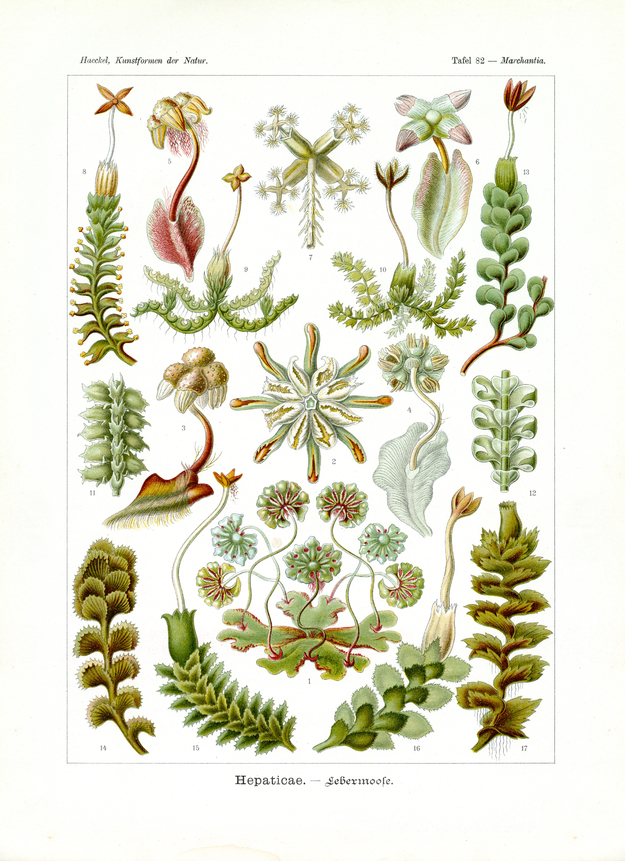The small and tender ‘presprouting plants’, joined together in the varied class of liverwort (Hepaticae), can be allocated to two different subclasses, ‘bed-mosses’ and ‘leave-mosses’. The older and lower class is the ‘bed-mosses’ (Thallobryia, fig. 1-7); a differentiation in stem and leave is not yet developed, their multi-cellular body forms a simple frame (Thallus) as in Algae (plates 15 and 65) and in Fungi (plates 63 and 73); they are directly related to green algae (Chlorophyceae), from which they originate (Ulvazea among the latter lead to Ricciazea within the liverworts). The younger and superior subclass are the ‘leave-mosses’ (Phyllobryia, fig. 8-17); the contrast of stem and leave is developed here as in the higher located ‘foliage-mosses’ (Muscinae, plate 72).
Developmental history of ‘liver-mosses’ is connected with alteration of generations (Metagenesis), just like the history of ‘foliage-mosses’. Out of a fertilized ovocyte (or stem cell, Cytula), produced by the first, sexual generation, a second, asexual generation develops in the form of a ‘gamete-capsule’ (Sporogonium, also known as “moss-fruit, moss-casket”). This brown, yellow or red gamete-capsule is usually ovoid, long-stemmed and dehiscing into four flaps in the course of maturing thus releasing the mass of small gametes or spores that are contained in it (fig. 8-10, 13, 15 and 16). In the process of germination of the plant out of each spore a sexual generation develops, ‘flower-moss’ (Bryogonium); in ‘bed-mosses’ (fig. 1-7) it grows to a simple, leaf-shaped Thallus, in ‘leave-mosses’ (fig. 8-17) into a foliate stem. Later ‘moss-blossoms’ develop out of these, consisting of smaller, male seminal vesicles and bigger, female ‘ovum-containers’. Inside the seminal vesicles (Antheridia or Spermaria) flexible flagellate cells (Spermatozoa with two swinging flagella) evolve, in the ‘ovum-containers’ (Archegonia or Ovaria) single, big ovocytes. The latter ones being fertilized by the former ones Sporogonium, “moss-fruit” comes into being. A good number of ‘bed-mosses’ generate tender inflorescences (Receptacula) with flowers getting enclosed in perianths (Perianthium) and thus joined in groups, so in Marchantiazea (fig. 1-7).
Translation of the original German introduction by Ernst Haeckel:
Division of Diaphyta or Archegoniata (Vorkeimpflanzen); - main class of Bryophyta (Moospflanzen); - class of Hepaticae (Lebermoose).
Translation by VR Translators Bangalore
This is one of the 100 pop science biology illustrations that were published from 1899 – 1904 in Leipzig by Ernst Haeckel through Verlag des Bibliographischen Instituts.
We've scanned the original lithography at 1200dpi on the Epson A3 scanner of A3 scanner huren. You can download a 400dpi JPEG here.
